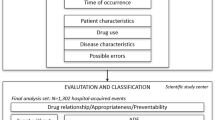Summary
Case summaries of 2490 patients treated at the Department of Infectious Diseases, Danderyd Hospital, in 1986 were reviewed for discharge diagnoses where the International Classification of Disease (ICD) code indicated an adverse drug reaction (ADR) [E 939,9 in ICD 8]. Of 48 patients whose case summaries indicated an ADR, only 10 (21%) had been reported on ‘yellow cards’ to the Swedish Adverse Drug Reactions Advisory Committee. The Committee had also received from the same department 3 reports where the case summary lacked an ADR code.
The information on drug treatment with respect to dosage, duration and treatment with concomitant drugs was not complete in the case summaries but sufficient for a preliminary evaluation of the suspected reactions in all but 4 of the cases. On the basis of these findings the authors do not reach an outright conclusion in favour of replacing the ‘yellow card’ system but the possible benefits of a system in which ‘yellow cards’ are supplemented by automatic referral of all case summaries containing an ICD code indicating an adverse drug reaction was judged sufficient to recommend and initiate a large field study.
Similar content being viewed by others
References
Arneborn P, Palmblad J. Drug induced neutropenia in the Stockholm area 1973–78. Acta Medica Scandinavica 212: 289–292, 1982.
Boman G, Claesson C, Göransson P. Registration of adverse drug reactions at the University Hosital of Uppsala. Läkartidningen 77: 2048–2050, 1980.
Böttiger LE, Hast R, Holmberg L. Vem anmäler läkemedelsbiverkningar? (Who reports on side effects of drugs?) Läkartidningen 76: 860–863, 1979.
Böttiger LE. Nya regier för anmälan av läkemedelsbiverkningar (New rules for the reporting of adverse drug reactions). Läkartidningen 71: 5288–5290, 1974.
Böttiger LE, Westerholm B. Drug induced blood dyscrasia in Sweden. British Medical Journal 3: 339–342, 1973.
Fagius J, Osterman P-O, Sidën Å, Wiholm B-E. Guillain-Barré syndrome following zimeldine treatment. Journal of Neurology, Neurosurgery and Psychiatry 48: 65–69, 1985.
Griffin J, Weber JCP. Voluntary systems of adverse reaction reporting — Part II. International comparison of spontaneous adverse reaction reporting systems. Adverse Drug Reactions and Acute Poisoning Reviews 1: 23–55, 1986.
Jorup-Rönström C, Britton S. Efficacy of reporting systems of adverse reactions to drugs and care. Scandinavian Journal of Social Medicine 11: 87, 1983.
Jorup-Rönström C, Britton S. The nosocomial component of medical care. Scandinavian Journal of Diseases 36 (Suppl.): 150–156, 1982
Author information
Authors and Affiliations
Rights and permissions
About this article
Cite this article
Jorup-Rönström, C., Keisu, M. & Wiholm, BE. Could Swedish ‘Yellow Cards’ Be Substituted by E-Coded Summaries?. Drug-Safety 5, 72–77 (1990). https://doi.org/10.2165/00002018-199005010-00007
Published:
Issue Date:
DOI: https://doi.org/10.2165/00002018-199005010-00007



